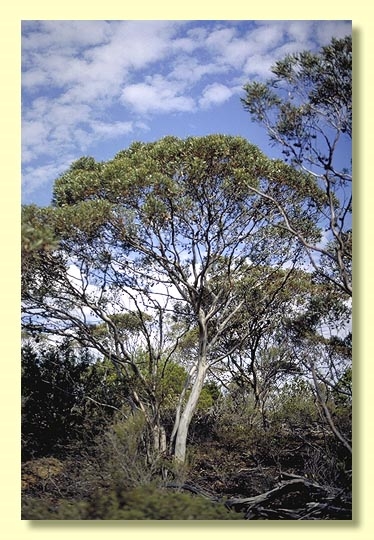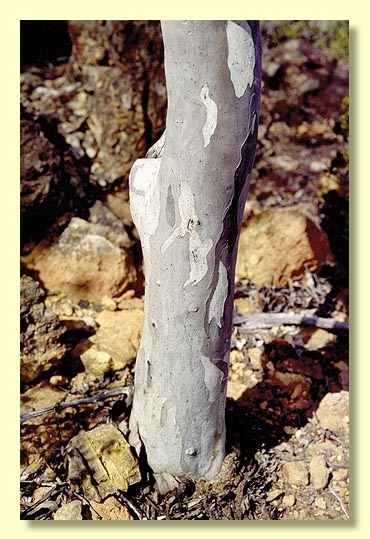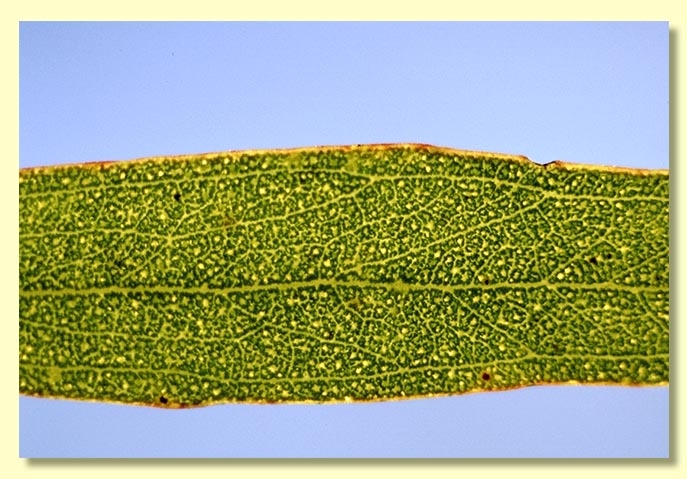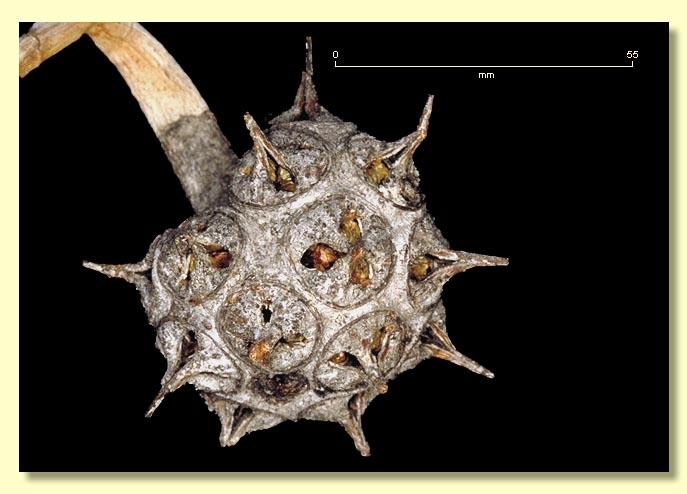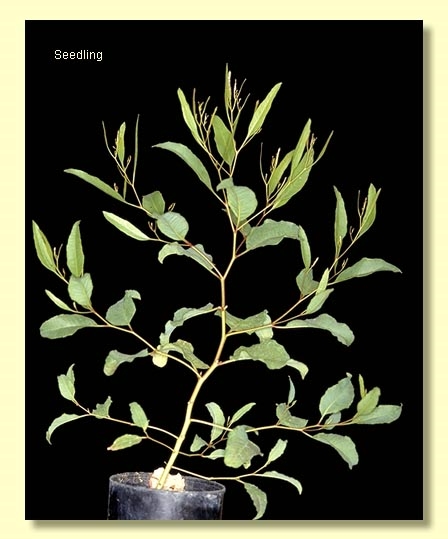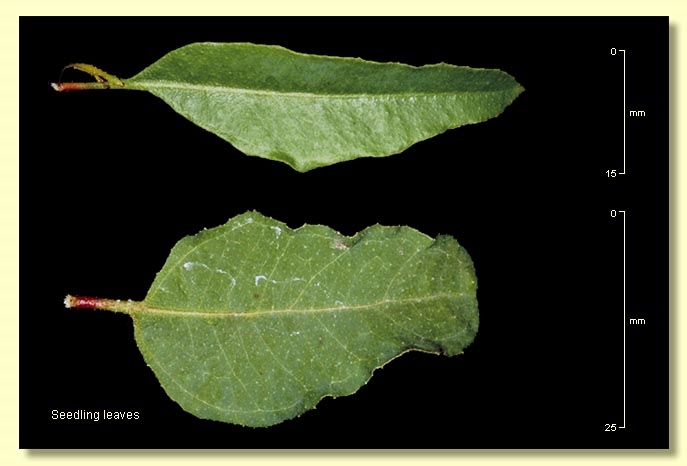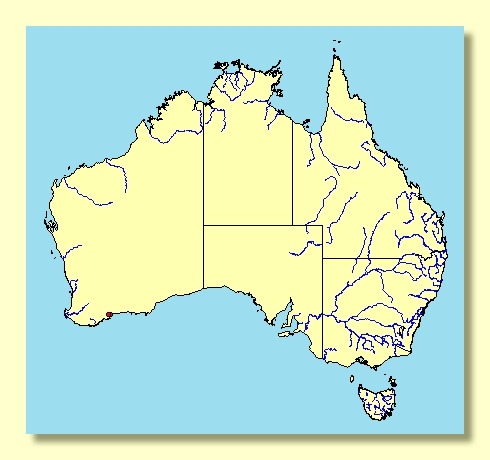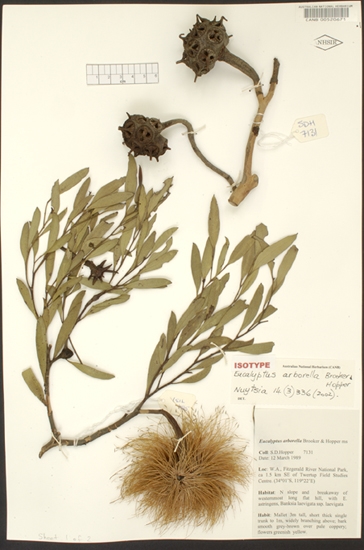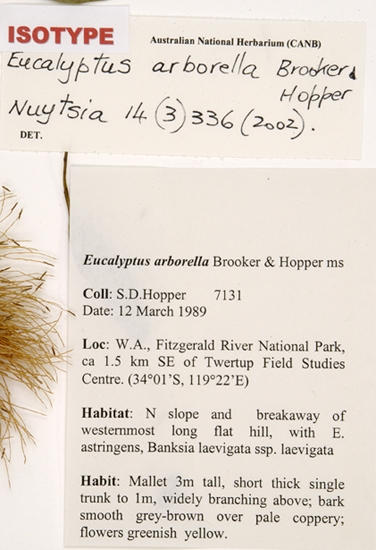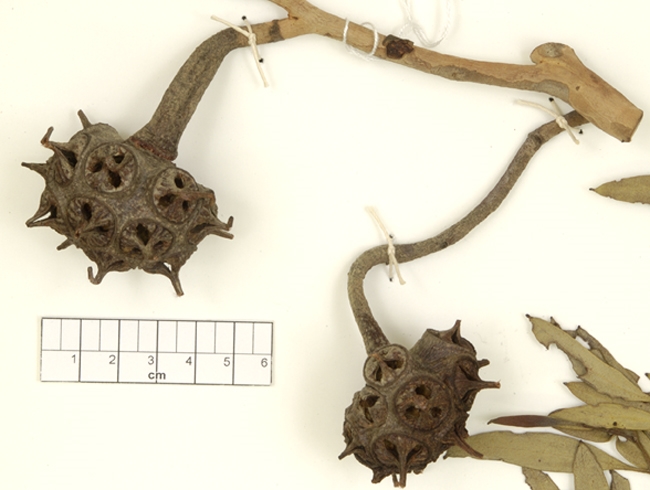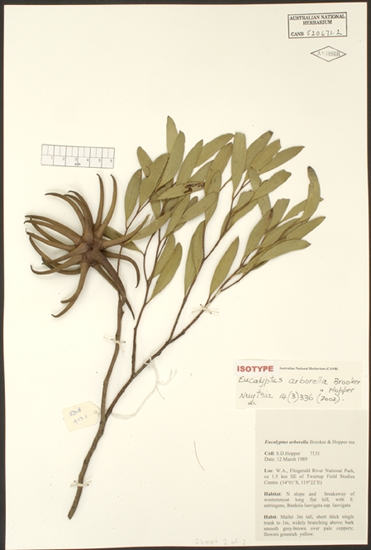Euclid - Online edition
Eucalyptus arborella
Eucalyptus | Symphyomyrtus | Bisectae | Hadrotes | Lehmannianae | Conjunctae
Bark smooth throughout, pale grey and whitish, sometimes pale pink to pale coppery.
Branchlets lacking oil glands in the pith.
Juvenile growth (coppice or field seedlings to 50 cm): not seen.
Adult leaves alternate, petioles 0.5–1 cm long; blade narrowly elliptical to narrowly oblanceolate, 4–7 cm long, 0.7–1.5 cm wide, base tapering to petiole, margin entire, apex pointed, concolorous, green, glossy, side-veins acute, reticulation moderate to dense and broken, intramarginal vein remote from margin, oil glands obscurely island, irregularly shaped.
Inflorescence axillary unbranched, peduncles strap-like, down-turned at bud maturity, 3.5–7.5 cm long, buds ?11 to 15 or more per umbel, pedicels absent. Buds syncarpous (all of the buds in a cluster are completely joined by the hypanthium (base) only, the upper part of each bud remains free. At maturity the combined length of the fused part plus operculum is ca 4.5–6.5 cm, whilst width of individual buds measured at the base of the operculum is 0.7–1.2 cm); scar present (outer operculum lost early) but may be difficult to see at bud maturity, operculum often curved, 5–8 times the length of the fused part of the bud (opercula 3.8-5 cm long), stamens completely erect, anthers narrowly oblong, versatile, dorsifixed, dehiscing by longitudinal slits, style long and straight, stigma blunt, small, locules 3, the placentae each with 4 vertical rows of ovules. Flowers greenish.
Fruit on down-turned peduncles, syncarpous, the individual capsules in the woody mass 0.9–1.5 cm wide, length not measurable, dehiscing by elliptical holes formed as the 3 valves split along the sutures but remain ± fused apically, disc covering the surface of the valves.
Seeds black, 1–4 mm long, ovoid to more or less angularly so, dorsal surface shallowly reticulate, hilum ventral/terminal.
Cultivated seedlings (measured at node 10): cotyledons Y-shaped (bisected), robust; stems at first triquetrous but soon rounded in cross-section, scabrid; leaves always petiolate, opposite for 3 to 6 nodes then alternate, deltoid to ovate, 4–5.5 cm long, 2.5–5 cm wide, dull, green to grey-green; stem, petioles quite scabrid, lamina and margins slightly scabrid, at least until nodes 12–15, with bristle glands.
Flowering has been recorded in January, March and April.
A mallet endemic to Western Australia, with southern near-coastal distribution. It is found in Fitzgerald River National Park and near Corackerup, on rocky sites (slopes and tops of spongiolite mesas). It has smooth bark and glossy green crown in which the large pendulous fused bud and fruit clusters are easily seen. Opercula are long and slender and stamens long yellow-green.
Eucalyptus arborella belongs in Eucalyptus subgenus Symphyomyrtus section Bisectae subsection Hadrotes because the cotyledons are coarsely bisected, buds have an operculum scar, a long (inner) operculum and erect stamens, fruit are large, thick-rimmed and held rigidly. There are 12 species in subsection Hadrotes, two species (E. macrandra, E. cornuta ) have oil glands in the pith whilst 10 species lack these oil glands. Together these 10 species form series Lehmannianae, a group further characterised by having scabrid seedlings and fruit with exserted valves that remain fused at their tips after seed is shed, a feature shared with the more distantly related E. cornuta.
Of the ten species in series Lehmannianae six species, E. lehmannii, E. conferruminata, E. arborella, E. mcquoidii, E. sinuosa and E. retusa have the buds (and fruit) in each axillary cluster fused basally (subseries Conjunctae) whilst the other four, E. newbeyi, E. burdettiana, E. talyuberlup, and E. megacornuta, have buds and fruit in each umbel basally free (subseries Liberae). The scabridity of the seedling leaves of these ten species is due to emergent multicellular oil glands.
E. arborella differs from E. lehmannii in its mallet (non-lignotuberous) habit and in having broader deltoid, not ovate, seedling leaves. Both these species have broadly flattened down-turned peduncles, bud clusters of similar size (up to ca 21 buds per cluster) and opercula that are very long and slender. E. mcquoidii differs in being a non-lignotuberous shrub (marlock) or stunted mallet with terete down-turned peduncles, many more buds per cluster (to ca 50) but with similar graceful slender opercula. The mallee E. sinuosa also differs from E. arborella in having terete peduncles and longer opercula that are sinuose at the ends. E. conferruminata is also a marlock or mallet but has flattened down-turned peduncles, also with up to 21 buds per cluster but stout relatively short opercula (< 5 times as long as wide). The sixth species in this group, the mallee E. retusa, has distinctive stiff obovate leaves to 5.5 cm long and incompletely fused bud clusters that are held erect and are smaller than the other species.

